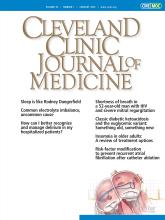Article Figures & Data
Tables
- GLUCAGON RELEASE IN EDKA: PLAUSIBLE PATHOPHYSIOLOGIC MECHANISMS
SGLT receptors are expressed by islet alpha cells. However, although SGLT-1 receptors have been described, evidence supporting the presence of SGLT-2 receptors in alpha cells is inconsistent, and cross-reactivity of SGLT-2 inhibitors on the SGLT-1 receptor is unlikely.2
Paracrine effects on the secretion of glucagonotropic and static substances from other islet cells have been proposed as an alternative mechanism, but this hypothesis has not been conclusively proven.
Of interest is the presence of a renal–pancreatic loop, which suggests that glycosuria caused by the SGLT-2 inhibitor and the associated lowering of circulating glucose triggers the increase in glucagon. This hypothesis is supported by data from glucose clamping experiments in which the rise in glucagon was prevented if the blood glucose level did not change during SGLT-2 inhibitor therapy.2
- TABLE 1
Potential higher risk factors of euglycemic diabetic ketoacidosis and their mechanisms
Risk factor Mechanism History of prior diabetic ketoacidosis Indicates significant insulin deficiency Hemoglobin A1c > 10% Suggests insulin deficiency Bicarbonate < 18–20 mmol/L Preexisting acidosis Creatinine < 0.5 mg/dL Low muscle mass with reduced ability to metabolize ketones Chronic creatinine > 1.5 mg/dL Acidosis risk higher Acute renal injury Preexisting acidosis Factor Diabetic ketoacidosis Euglycemic diabetic ketoacidosis Endogenous insulin Not stimulable Stimulable Administered glucose No benefit at onset Benefit at onset Renal glucose threshold (reference 180 mg/dL) Elevated above normal Lower than normal Duration of ketosis under treatment Up to 15–20 hours Up to 60 hours from the last dose of sodium-glucose cotransporter 2 inhibitor






